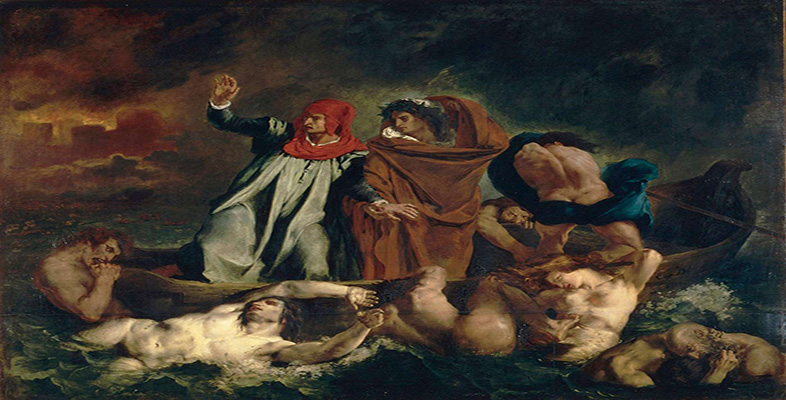6.5 Romanticising the Oriental
Heroic Byronic quests such as that of the Giaour were ideally suited to Delacroix’s taste and formed part of his Romantic modernity. In the preface to his 1829 collection of poems, The Orientals, Victor Hugo describes Oriental themes as part of the rich tapestry of subject matter to be mined by Romantics. He suggests that literature should be like a medieval Spanish town that juxtaposes winding streets and Gothic cathedrals with the domes and partitions of a mosque – a graphic illustration of the crossing of aesthetic and cultural boundaries that have in common their opposition to the straight lines and order of the previously dominant neoclassical style.
The Oriental might be seen, then, as a convenient conduit for Delacroix’s expressive genius. You may remember that he described inspiration as a ‘slumbering lion, whose roarings stir your very being’ (Pach, 1938, p.94). The combat of the Giaour, the drama and sumptuous frenzy of Sardanapalus’s palace: these subjects fed his desire, as a Romantic, to escape imaginatively to a world more colourful and dramatic than that which he inhabited in reality. The exotic was, to late eighteenth- and early nineteenth-century thinkers and artists, the blatantly foreign, strange or unfamiliar. In his educational treatise Émile (1762) Rousseau, drawing on a gardening analogy, describes as ‘exotic’ that which is obviously opposed to the native, as he decries the bad effects wrought by society on nature and human nature: ‘By human art is our native soil compelled to nourish exotic plants, and one tree to bear the fruits of another’ (Eliot and Whitlock, 1992, vol.II, p.171).
The exotic is different or ‘other’. By calling attention to its difference from the native or familiar, it gives us a clearer sense of our own identity or viewpoint. Similarly, Wordsworth criticised the ‘profanation’ of the native (Lakes) landscape resulting from the fashion for implanting exotic villas in prominent positions within the original wilderness. And yet the exotic liberated the imagination, exuded energy and permitted the kinds of transgressive thinking favoured by many Romantics. The exotic has been defined by one scholar as ‘the artistic exploration of territories and ages in which the free flights of imagination were possible because they lay outside the restrictive operation of classical rules’ (Stevens, 1984, p. 17). It was also associated with the opportunity to explore new cultures outside Europe and a host of novel picturesque details (Le Robert, 2000, vol.I, p.815). Essentially, it allowed westerners to explore their own cultural values and mindset in a way that has been seen by some commentators (for example, Said, 1991) as a kind of exploitative cultural imperialism that can undermine the possibility of assessing ‘outsiders’ on their own terms, of viewing things from their perspective or of being judged by them. These risks are seen to be greatest where the power politics of empire hold sway, but they can also be increased where a particular aesthetic dominates. Such was the case, perhaps, with the Romantic picturesque, which manipulated and exploited the Oriental for its purely visual potential and (western) appeal without penetrating its own values or perspectives.
